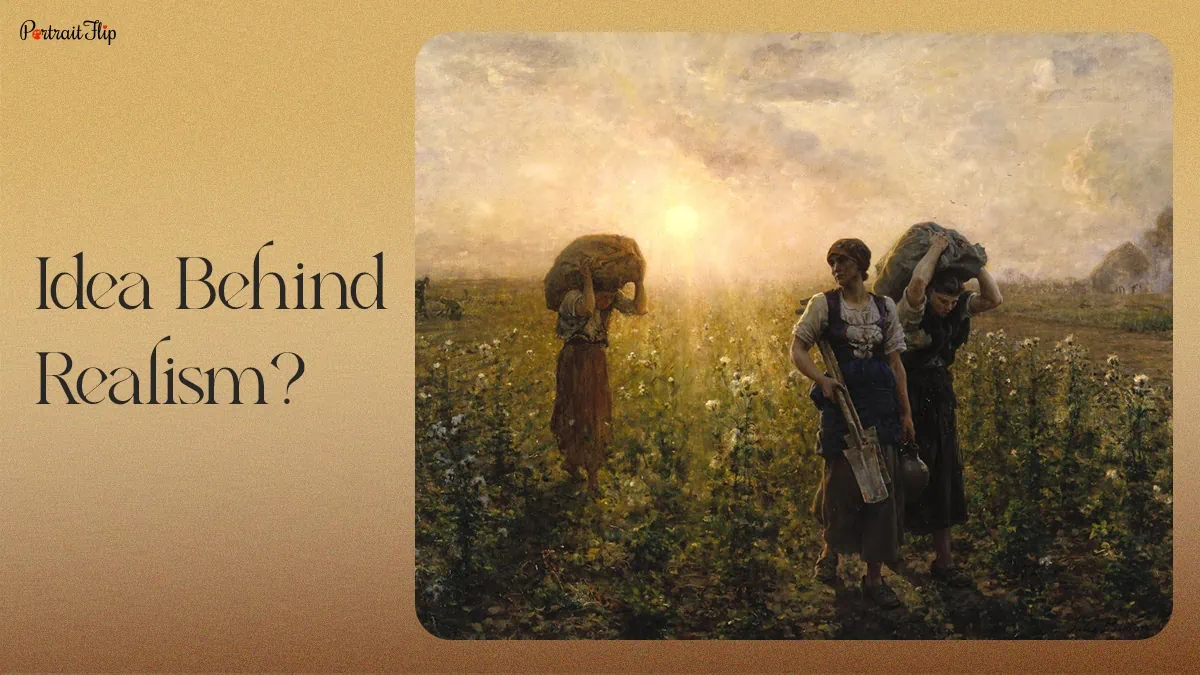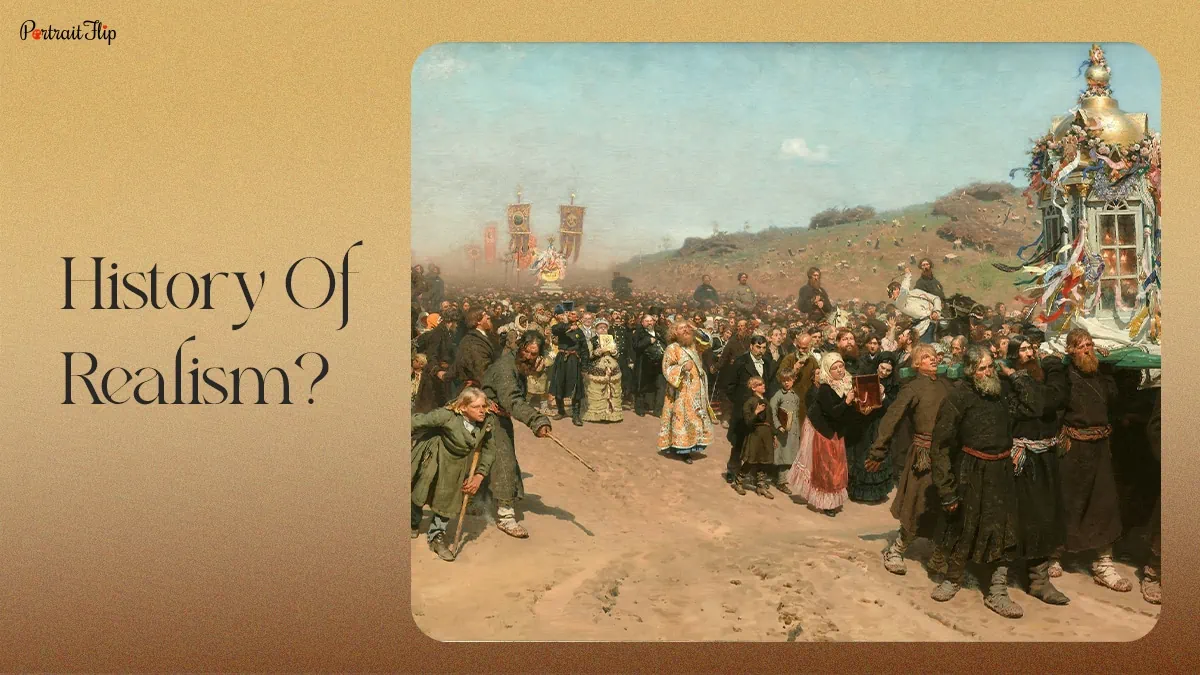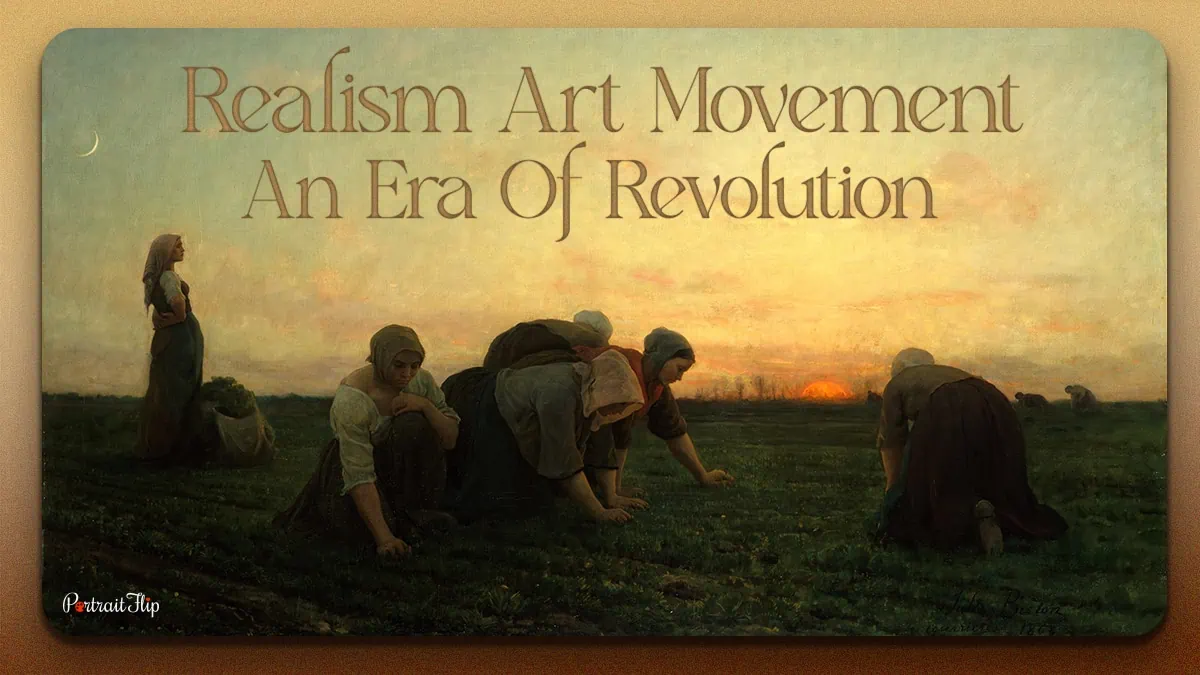Keeping it real, keeping it 100!
That is the motto of the Realism art movement.
As a realist, an artist portrays the world from his point of view.
A Realist artist is someone who clearly portrays what they see and what actually is going around them.
Realism art covered every situation, whether if it’s about the privileged society or people surviving in poverty.
The Realism art movement is regarded as the first modern art movement.
It rejected traditional forms of art, literature, and social organization.
It became outdated during the Industrial Revolution phase.
Let’s see how the realism art movement grew and became one of the most prominent art movements.
Table of contents
What is the Realism Art Movement?

In the middle of the nineteenth century, in France (Europe), a stylistic and social movement called “Realism” was born.
The Realism Art movement was the first modern movement to emerge in the decades following the Enlightenment and the Industrial Revolution.
It heavily criticized the standard forms of art, literature, and social structure as they went out of date.
The original Realism art definition described how this movement helped the artists be true to their canvases.
Realism art works on strategy and is a method of attempting to be contemporary without being abstract.
It is a counter-argument to idealism. It features aspects of art that are directly related to the theme and substance.
Additionally, this contemporary art movement emphasized the subject’s originality and depicted day-to-day events.
As a result of social changes like the French and Industrial Revolutions, many social intellectuals, including artists, shifted their focus more towards reality.
Early romanticism’s depictions sparked realism’s emergence. The artist’s imagination can then take off from there.
Idea Behind Realism

In nineteenth-century art, a close examination of how things appear on the outside was preferred as an imaginative idealization.
In the definition of art, realism refers to an accurate, minute, and unadorned depiction of the natural world or modern life.
The Realism art movement was a modern movement in art that was non-institutional, and nonconformist.
The movement was released following the print and mass media buzz during that era.
To find suitable subjects for their realism paintings, realists of the time turned to rural settings and very common places on the outskirts.
The subjects were very easily available in the locations like farms, factories, etc.
Its chief advocates were Gustave Courbet, Jean-François Millet, Honoré Daumier, and Jean-Baptiste-Camille Corot.
In the middle of the 19th century, realism was concerned with the social, political, economic, and cultural structures of life.
As a result, realism in its broadest sense has included a variety of artists across various civilizations.
Everyday objects were more viable and easily subjectable, and it was also easy to project day-to-day life.
Hence, Realism art became the visual representation of their portrayals and the thoughts they weren’t vocal about.
History of Realism

As a reaction to Romanticism and history-related paintings, the Realism art movement emerged.
Now, you may wonder, when did realism start?
Realism started spreading its roots in France in the 18th century as part of a broader response to constantly flipping governments and the economic exploitation of the colonies.
Industrialization provoked movements like Neoclassicism and Romanticism to go on a rough ride and hence disturbed them till the 19th century.
That’s when the Realism art movement came on the scene to aim at the actual lives the people were living through all the struggles.
Amid the nineteenth century’s aim to depict ‘real’ life, the realist painters used laborers, ordinary people, and easily available original subjects.
The reason why they used common and ordinary surroundings is that they wanted their paintings to leave a long-lasting impression on the viewer’s mind.
They also wanted to portray the everyday struggles of ordinary people’s lives and how engaged they were with the chores.
Realism was not just a straightforward depiction of nature; it was also an effort to demonstrate one’s own true science, morality, and politics.
It depicted everything between landscape acrylic portraits to political oil paintings.
Artists of the Realism Movement

1. Gustave Courbet (1819–1877)
2. Jean-François Millet (1814–1875)
3. Édouard Manet (1832–1883)
4. Thomas Eakins (1844–1916)
5. Ilya Repin (1844–1930)
Realism And Naturalism

Given that realism has a history of appearing in waves throughout art history, it will be safe to say that naturalism is a type of realism.
Realism refers to the real representation and depiction of the subject and is solely based on the narrative.
Naturalism, on the other hand, refers to the subject being in their natural state and is based on their visual appearance.
PS: The idea of painting photorealism emerged during abstract expressionism, following the success of naturalism and realism in the art world.
Now you might wonder, What is Photorealism?
In order to give you a quick overview, I’d like to emphasize that the paintings made during photorealism were similar to the actual photographs.
The artists modified the intricate arrangements and subsequent paintings in accordance with the characteristics of realism art, using photographs as their source of inspiration.
Suggested Read: Famous Spanish artists
Realism Representing French Society

Realist art is based on closer observations of contemporary life and subjects.
The artists who were already working for the movement struggled through their way and supported the movement to travel across France and to other countries as well.
The Industrial Revolution, which took place roughly around 1760–1860, brought significant modifications to a lot of units.
Whether it be manufacturing, transportation, or technology, the revolution started to have an impact on how people in Europe and America lived, worked, and traveled.
Amid these controversies, the realist movement emerged sometimes later and gradually with its unique methodology and idealistic style.
Even after becoming a French phenomenon, Realism gained supporters across Europe and the United States.
In the 1860s, James Abbott McNeill Whistler, an American painter, became friends with Courbet and specialized in realism.
Thomas Eakins became the United States best-known Realist painter.
He tried integrating photorealism into his artwork as well, and he tried to reveal the minute subjects with closer observations and study.
Like other artists, Pierre Auguste Renoir started a revolution with his brush later known as Impressionism. He produced some of the finest paintings.
Having a Renoir artwork on your wall would be like a utopian dream. However, It might get shattered after knowing the cost of the painting.
Exact replica paintings by PortraitFlip is sigh of relief. Check out Renoir reproduction paintings!
Impact of Realism on Modern Art

The Realism art movement attempted to merge the art world and modern life, resulting in the birth of modern art.
The modern art movement is frequently regarded as having its roots in realism.
The concept of modern art was associated with art that challenged the traditions and techniques that came before it, like realism and romanticism.
In the new era of modernism art, issues related to romanticism and classic idealism were avoided.
Instead, Modernism in art started evolving with time and it also carried the importance of Realism along with it.
The filthy and dirty aspects of the subjects were generally left out of the art because, according to the characteristics of modern art, they must be appealing.
Realist painters enjoyed channeling ongoing controversies through their subject matter in painting as well as depicting their class struggles.
Modern art was much easier to please the viewers, unlike the realist paintings, which definitely needed a lot of understanding and a point of view to be able to understand.
The new journey of modern art, which has now been around for more than 150 years in the art world, began with realistic art presented with a hint of abstraction.
Suggested Read: Pop Art Movement
Conclusion
This was it from my end about the realism art movement.
This movement has made sure to change the art world significantly. Also, it has welcomed revolutionary movements as well.
After realism, many movements started to evolve, including, Photorealism, Impressionism, Post-Impressionism, Cubism, etc.
There are numerous additional details and stories about the world of art.
I’ll discuss them in the upcoming blogs, so stay tuned!
Suggested Read: Famous Cubist Paintings
Author’s Note
Thank you for reading this article, in which I’ve tried to explain to you the Realism art movement.
I’ve collected data, information, and facts and put them meticulously into my own words.
So let me know how you found this blog by leaving a comment below.
Also, leave your thoughts and suggestions, as they matter to me and help me to rectify any mistakes as well as to create other blog posts.
You know we’ve been creating replicas of several renowned paintings; if interested, you can:
For more information and painting-related content, you can follow PortaitFlip on social media platforms such as Instagram, YouTube, and Pinterest.
au revoir!
Frequently Asked Questions
Gustave Courbet is famously known as the father of European Realism art movement.
The 19th century Realism art movement began in 1840, in France and it was a response to Romanticism.
Realism movement was developed in France, and in the 19th century the artists in this movement started to focus on the representation of reality of the ongoing real-life events in a naturalistic manner.
Realism movement came after the Romanticism movement, and in realism movement more truthful and real representation of the day-to-day life struggles of humans was the center of attention.





